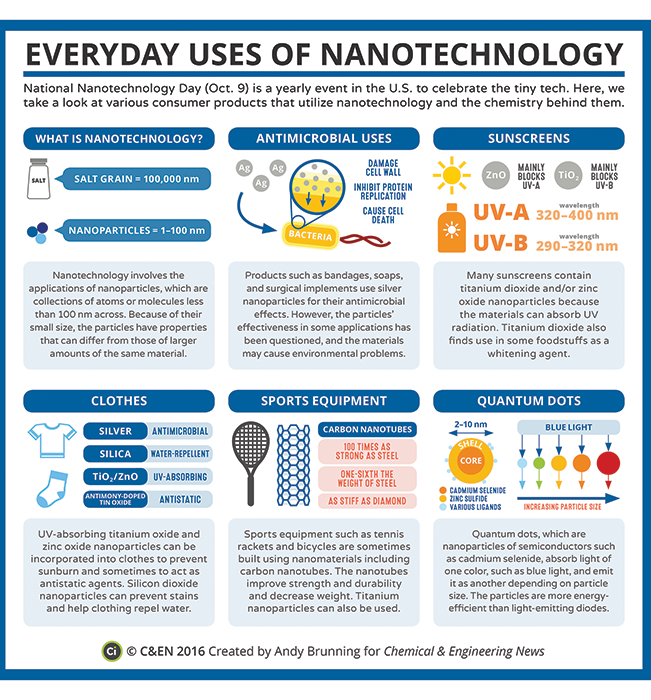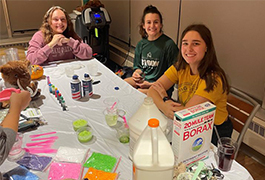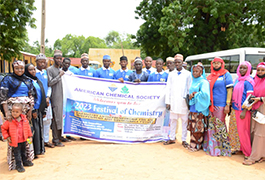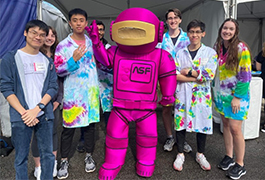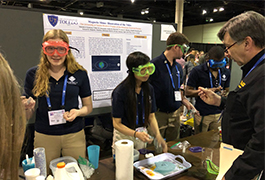Fun Ways to Celebrate National Nanotechnology Day on October 9
Last updated 9/19/2022
In The Memoirs of Sherlock Holmes, Sir Arthur Conan Doyle wrote, “It has long been an axiom of mine that the little things are infinitely the most important.” Some of the most important things in our daily lives are little indeed—1 to 100 x 10-9 m (or 1 – 100 nm), to be specific. In 2016, October 9 (10/9—wink, wink) was established as National Nanotechnology Day to celebrate everything made possible by the manipulation of atomic-scale materials and devices.
National Nanotechnology Day features a series of community-led events and activities to raise awareness of nanotechnology, including how it is currently used in products that enrich our daily lives and the challenges and opportunities it holds for the future.
This year, National Nanotechnology Day celebrates nanotechnology’s role in understanding and responding to climate change and improving the health of the Earth and its people.
Although examples of nanotechnology date back to 4th century Rome, when colloidal gold and silver (metal particles sizes around 10–100 nm) were used to create glass that changed color depending on the angle light struck the surface. The field itself didn’t emerge until the late 20th century, however, when advances in scientific theory and equipment made it possible to see and manipulate individual atoms.
In just a few decades, nanotechnology has gone from a hypothesis to a practical reality. From clothes to electronics, nanotechnology touches every aspect of our daily lives. And the field continues to grow. Whether you choose to explore on your own or with your chapter, there are many ways to investigate the advances in nanotechnology and how it is impacting our everyday lives.
Learn about nanotechnology’s role in understanding and responding to climate change
- Explore the enabling potential of a career in nanoscience and “doing good” with a career in environmental nanoscience and nanotechnology, with these video presentations from Virginia Tech’s NanoEarth program.
- Read about nanomaterials in the environment, where they are found, and how we can use nanotechnology to find them in the “Environment” issue of Nanooze, a magazine about science and nanotechnology for children. Also, learn about how nanotechnology helps to make, store and use energy in the “Energy” issue of Nanooze.
- Take a close look at shark skin; single-celled algae called diatoms; single-celled marine plants called coccolithophores; and other marine organisms under a scanning electron microscope. (The study of diatoms, for example, is important to understand climate change.)
- Explore these engineering activities & challenges and whiteboard animation videos for K–12 students from the Nanosystems Engineering Research Center for Nanotechnology-Enabled Water Treatment (headquartered at Rice University).
Try these fun outreach activities
- Explore ways nanotechnology is providing solutions to mitigate and adapt to climate change: Various nanomaterials or products containing nanomaterials are being used or tested to create cleaner and renewable sources of energy. Check out the following science experiments, which demonstrate how some of these nanomaterials work as well as provide examples of renewable sources of energy: Solar Cells: Juice from Juice; Silicon Solar Cell Efficiency; Solar Ovens – Understanding Energy Transfer.
- 100-Billion Nanometer Dash: Run #100BillionNanometers (100 meters) and share your pictures and videos on social media with #NationalNanoDay! Print a Certificate of Achievement and a Gold Medal for you or anyone who runs with you
- Host image, video, or illustration contests related to nanotechnology.
- Organize lab tours and open houses.
- Coordinate outreach events with demonstrations about nanotechnology.
(Check out resources at acs.org/nano and nano.gov). - Create and share an image, video, illustration, or infographic about nanotechnology: what it is, why it is important, and examples of nanotechnology applications.
- Host a Science Café or an informal discussion on nanotechnology. If you are a K–12 student or teacher, you could invite a scientist from a local college or university.
Fun activities to do at home
- Exploring Nano: Even though we can’t see things at the nanoscale with our eyes, there are fun ways to explore the surprising properties of nanomaterials. Check out the following science experiments: Egg Drop, Mystery Sand, Rainbow Film, and Invisible Sunblock. You can do these activities at home using items purchased at your local store.
- Sizing Up Nano: How do objects at the nanoscale compare with bigger things that we see around us? Check out the following science experiments that help illustrate how small the nanoscale is and the tools that are available to “see” at the nanoscale: Exploring Size - Memory Game (Card Deck), Exploring Size - Powers of 10 Game (Card Deck), Ready, Set, Fizz!, Noodling Around: Powers of 10, Mitten Challenge, and Mystery Shapes. You can do these experiments at home using items you can buy at your local store.
So, what do you think? Would you be interested in celebrating National Nanotechnology Day? It can be as simple as sending a Tweet (#NationalNanoDay) on October 9!
If you have questions about National Nanotechnology Day, please feel free to contact the National Nanotechnology Coordination Office at nnd@nnco.nano.gov.
Infographics
Websites
Nano.gov
The National Nanotechnology Initiative website features information, events, educational resources, publications, and initiatives of over 20 U.S. government departments and independent agencies agencies focused on nanotechnology R&D.

Communities
NextTech Student Network
Learn about student groups student group dedicated to raising awareness of nano and emerging technologies.
About Nanotechnology
Nanotechnology is the understanding and control of matter at the nanoscale, at dimensions between approximately 1 and 100 nm, where unique phenomena enable novel applications. Matter can exhibit unusual physical, chemical, and biological properties at the nanoscale, differing in important ways from the properties of bulk materials, single atoms, and molecules. Some nanostructured materials are stronger or have different magnetic properties compared with other forms or sizes of the same material. Others are better at conducting heat or electricity. They may become more chemically reactive, reflect light better, or change color as their size or structure is altered.
Nanotechnology encompasses nanoscale science, engineering, and technology in fields such as chemistry, biology, physics, materials science, and engineering. Nanotechnology research and development involves imaging, measuring, modeling, and manipulating matter between approximately 1 and 100 nm.
It’s difficult to imagine just how small that is, so here are some examples:
∎ A sheet of paper is about 100,000 nm thick.
∎ A strand of human DNA is 2.5 nm in diameter.
∎ There are 25,400,000 nm in one inch.
∎ A human hair is approximately 80,000–100,000 nm wide.
∎ A single gold atom is about one-third of a nanometer in diameter.
More information about nanotechnology and the National Nanotechnology Initiative can be found at nano.gov


